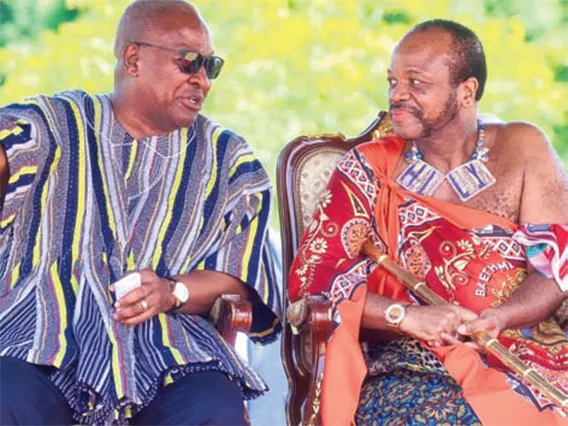A Royal Call for Intra-African Trade: King Mswati III’s Historic Visit to Ghana
King Mswati III of Eswatini embarked on a landmark visit to Ghana, marking the first time a reigning monarch from the Southern African nation has set foot on Ghanaian soil. This historic trip, laden with diplomatic significance, served as a platform for the King to champion a cause close to his heart: the strengthening of trade ties within the African continent. His message resonated powerfully with Ghanaian officials, who echoed his sentiments and pledged to work towards closer collaboration between the two nations.
The King’s central argument revolved around the untapped potential of intra-African trade. He lamented the current low levels of commerce between African countries, a situation he believed was hindering the continent’s economic progress. He pointed to the African Continental Free Trade Area (AfCFTA) agreement as a promising framework, but stressed that its success hinges on substantial investments in infrastructure and logistical networks. This, he argued, would facilitate the smooth flow of goods and services across borders, unlocking the true power of the AfCFTA and driving economic growth.
Beyond trade, King Mswati III emphasized the importance of cultural exchange and shared learning between African nations. He expressed his delight at the opportunity to connect with the people of Ghana, highlighting the common ground between the two countries in terms of culture and lifestyle. He envisioned a future where African countries learn from each other’s experiences, sharing best practices and developing innovative solutions to shared challenges. This collaborative approach, he believed, would accelerate development and foster a stronger sense of unity across the continent.
President John Dramani Mahama, Ghana’s leader, warmly welcomed King Mswati III and expressed Ghana’s eagerness to deepen its relationship with Eswatini. He affirmed Ghana’s commitment to exploring and maximizing the potential benefits of cooperation with Eswatini, particularly in the realms of trade and investment. This mutual commitment signaled a shared vision for a more integrated and prosperous Africa, with both countries recognizing the value of collaboration in achieving this goal.
To solidify their renewed partnership, Ghana and Eswatini formalized their commitment with a Memorandum of Understanding (MoU). This agreement served as a tangible symbol of their shared intent to work together and laid the foundation for future collaborations. The signing of the MoU demonstrated the seriousness with which both nations approached this partnership, signifying a move beyond rhetoric to concrete action.
Following the official engagements in the capital city of Accra, King Mswati III journeyed to Kumasi, the historical and cultural heartland of the Ashanti Kingdom. There, he was received as a distinguished guest of the Asantehene, Otumfuo Osei Tutu II. His itinerary included courtesy calls on local authorities, a visit to the Manhyia Palace Museum, and an address to the National House of Chiefs. These engagements allowed the Swazi monarch to immerse himself in Ashanti culture and build personal connections with key figures in the region.
The culmination of the Kumasi leg of the visit was a grand durbar of chiefs held in King Mswati III’s honor at the Manhyia Palace. This colorful and culturally rich event showcased the vibrant traditions of the Ashanti people and served as a fitting tribute to the visiting monarch. A royal banquet hosted by the Asantehene followed, further cementing the bonds between the two kingdoms.
The visit concluded with a joint appearance by King Mswati III and Otumfuo Osei Tutu II at a special ceremony held at the Kwame Nkrumah University of Science and Technology (KNUST), a leading institution of higher learning in Ghana. This symbolic gesture underlined the importance of education and knowledge sharing in fostering development and cooperation.
King Mswati III’s visit to Ghana transcended mere diplomatic pleasantries. It represented a powerful call to action for increased intra-African trade and collaboration. His message resonated with Ghanaian leaders, who shared his vision for a more integrated and economically vibrant Africa. The visit also served as a testament to the enduring power of cultural exchange and the importance of building strong relationships between African nations. The historic encounter between the Swazi monarch and the Asantehene symbolized a bridging of cultures and a strengthening of ties between West and Southern Africa, offering a glimpse into a future where African nations work together to unlock their collective potential. The MoU signed between the two nations provided a concrete framework for future cooperation, signaling a move towards tangible action and a shared commitment to building a more prosperous future for both Eswatini and Ghana, and indeed, for the entire African continent.


